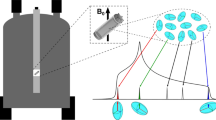Abstract
The identification of compounds that bind to a protein of interest is of central importance in contemporary drug research. For screening of compound libraries, NMR techniques are widely used, in particular the Water-Ligand Observed via Gradient SpectroscopY (WaterLOGSY) experiment. Here we present an optimized experiment, the polarization optimized WaterLOGSY (PO-WaterLOGSY). Based on a water flip-back strategy in conjunction with model calculations and numerical simulations, the PO-WaterLOGSY is optimized for water polarization recovery. Compared to a standard setup with the conventional WaterLOGSY, time consuming relaxation delays have been considerably shortened and can even be omitted through this approach. Furthermore, the robustness of the pulse sequence in an industrial setup was increased by the use of hard pulse trains for selective water excitation and water suppression. The PO-WaterLOGSY thus yields increased time efficiency by factor of 3–5 when compared with previously published schemes. These time savings have a substantial impact in drug discovery, since significantly larger compound libraries can be tested in screening campaigns.




Similar content being viewed by others
References
Dalvit C, Pevarello P, Tato M, Veronesi M, Vulpetti A, Sundstrom M (2000) Identification of compounds with binding affinity to proteins via magnetization transfer from bulk water. J Biomol NMR 18:65–68
Dalvit C, Fogliatto G, Stewart A, Veronesi M, Stockman B (2001) WaterLOGSY as a method for primary NMR screening: practical aspects and range of applicability. J Biomol NMR 21:349–359
Ernst RR, Bodenhausen G, Wokaun A (1987) Principles of nuclear magnetic resonance in one and two dimensions. Oxford University Press, Oxford
Fernández C, Adeishvili K, Wüthrich K (2001) Transverse relaxation-optimized NMR spectroscopy with the outer membrane protein OmpX in dihexanoyl phosphatidylcholine micelles. Proc Nat Acad Sci USA 98:2358–2363
Fiaux J, Bertelsen EB, Horwich AL, Wüthrich K (2002) NMR analysis of a 900K GroEL-GroES complex. Nature 418:207–211
Fylstra D, Lasdon LS, Watson J, Waren AD (1998) Design and use of the Microsoft Excel Solver. Informs Interfaces 28:29–55
Grzesiek S, Bax A (1993) The importance of not saturating H2O in Protein NMR—application to sensitivity enhancement and NOE measurements. J Am Chem Soc 115:12593–12594
Hiller S, Wider G, Etezady-Esfarjani T, Horst R, Wüthrich K (2005) Managing the solvent water polarization to obtain improved NMR spectra of large molecular structures. J Biomol NMR 32:61–70
Hopson RE, Peti W (2008) Microcoil NMR spectroscopy: a novel tool for biological high throughput NMR spectroscopy. Methods Mol Biol 426:447–458
Hwang TL, Mori S, Shaka AJ, van Zijl PCM (1997) Application of phase-modulated CLEAN chemical EXchange spectroscopy (CLEANEX-PM) to detect water-protein proton exchange and intermolecular NOEs. J Am Chem Soc 119:6203–6204
LeMaster DM (1994) Isotope labeling in solution protein assignment and structural-analysis. Prog Nucl Magn Reson Spectrosc 26:371–419
Liu ML, Mao XA, Ye CH, Huang H, Nicholson JK, Lindon JC (1998) Improved WATERGATE pulse sequences for solvent suppression in NMR spectroscopy. J Magn Reson 132:125–129
Ludwig C, Michiels PJ, Wu X, Kavanagh KL, Pilka E, Jansson A, Oppermann U, Günther UL (2008) SALMON: solvent accessibility, ligand binding, and mapping of ligand orientation by NMR spectroscopy. J Med Chem 51:1–3
Pervushin K, Riek R, Wider G, Wüthrich K (1997) Attenuated T-2 relaxation by mutual cancellation of dipole-dipole coupling and chemical shift anisotropy indicates an avenue to NMR structures of very large biological macromolecules in solution. Proc Nat Acad Sci USA 94:12366–12371
Shuker SB, Hajduk PJ, Meadows RP, Fesik SW (1996) Discovering high-affinity ligands for proteins: SAR by NMR. Science 274:1531–1534
Sklenar V, Piotto M, Leppik R, Saudek V (1993) Gradient-tailored water suppression for H-1-N-15 HSQC experiments optimized to retain full sensitivity. J Magn Reson A 102:241–245
Acknowledgements
We would like to thank Sebiastian Hiller, Claudio Dalvit and Helena Kovacs for stimulating discussions, and Sandra Jacob and Hans Widmer for critical reading of the manuscript. The authors are indebted to Alain Dietrich for his excellent technical support.
Author information
Authors and Affiliations
Corresponding author
Electronic supplementary material
Below is the link to the electronic supplementary material.
Rights and permissions
About this article
Cite this article
Gossert, A.D., Henry, C., Blommers, M.J.J. et al. Time efficient detection of protein–ligand interactions with the polarization optimized PO-WaterLOGSY NMR experiment. J Biomol NMR 43, 211–217 (2009). https://doi.org/10.1007/s10858-009-9303-5
Received:
Accepted:
Published:
Issue Date:
DOI: https://doi.org/10.1007/s10858-009-9303-5




